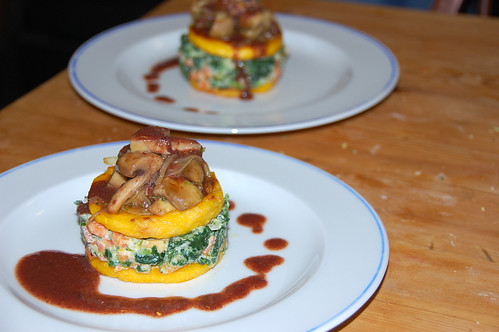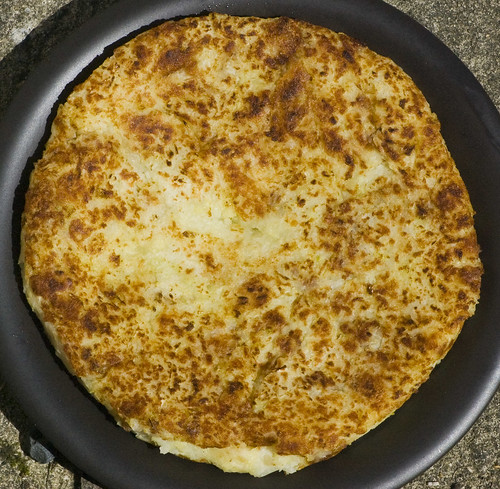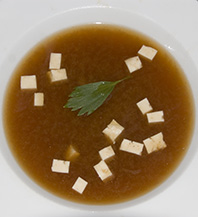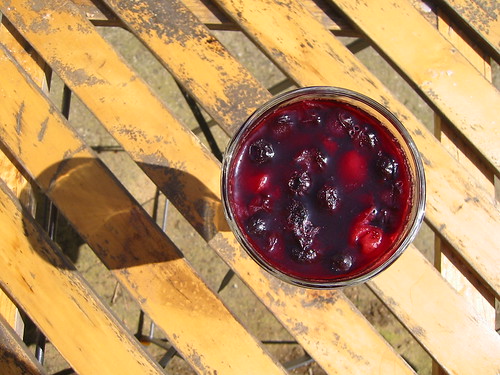
After the serendipitous purchase of a CD of Hawaiian music on a trip to Clapham recently we decided the only way to make good use of it was to host a small Hawaiian supper for our friends.
Of course, never having been to Hawaii brought some obstacles of comprehension and the fact that the traditional diet of this island population revolves around stodge and pig meat other problems but the interweb is your friend when researching alien cultures and a menu suitable for vegans was eventually created.
Getting some of the ingredients proved beyond me - there is sometimes taro in Tesco but I couldn't get there so we had no Poi which was a blow, although previous experiences of eating taro didn't convince me I would have enjoyed it a second time anyway. Lu'au, the young leaves of taro were also in short supply - not entirely unobtainable, there are still a few leafy tops adorning a plant in my greenhouse but perfectly inadequate for the sustenance of several hungry dinner guests even when the issue of calcium oxalate is discounted. So it's not an entirely
authentic dining example but it is amusing, particularly with sufficient iced Margaritas for all concerned.
In fact it was the prevalence of alcohol that accounts for the sad lack of pictures of sexy food so you'll just have to imagine what they looked like and thank
Tomo Yun for his nice picture of an Hawaiian beach
So for starters we had:
Sweet Potato oven fries with a Maui Onion Dip and Musubi.Sweet Potato fries are easily explained, peel and slice some sweet potatoes (I don't know the variety they had in the Co Op but they were the fairly small, intensely orange sort) and divide lengthways into neat wedges, cover in a little oil, either brushed on or by tossing in a pan with a couple of teaspoonfuls and bake in a hot oven for about 45 minutes turning a couple of times until cooked, browning and crispy. Turn onto a hot plate and sprinkle with salt.
The
Maui onion dip really needs those large sweet onions, Spanish or even Hawaiian if you can get them. Since I couldn't I used ordinary cooking onions but blanched them briefly to remove some of the potency.
Make a marinade from 250ml water, 200ml sugar and 125ml white wine or rice vinegar by bringing the water to a boil, dissolving the sugar in it, allowing it to simmer for a couple of minutes then removing from the heat, adding the vinegar and allowing the whole lot to cool to room temperature.
Peel and finely chop your onions, I used about three medium to small ones. Blanch by dropping into a pan of boiling water for a minute. Drain thoroughly and put in the marinade. Leave this overnight to soak. When you need the dip, drain off the marinade and put the onions into a bowl with about half a jar of Plamil Egg free mayonnaise (or your favourite vegan mayo), mix well and add a pinch of celery seed. This isn't fine dining.
Musubi really do seem to be the deep fried Mars bar of island life. You haven't lived until you've tried it! And what is it? Something that is best envisaged as a Spam Sushi roll although strictly speaking it's not a form of Sushi which requires vinegar seasoned rice.
It's another example of inventiveness following on from the introduction of an exotic foodstuff to an isolated community. In this case the foodstuff was Spam, that reviled substance found in tins across the world as an almost indestructible canned comestible, ideal for long ocean journeys of exploration and storage in tropical climates. The nicest touch is that the whole package is used, the Spam for eating and the can for forming the roll, a truely awesome touch of genius.
Of course, Spam is not suitable for a vegan diet but where tradition fails us a niche market is found and Fry's Polony is without doubt an excellent and authentic looking substitute. Unfortunately the plastic wrap this comes in is totally useless for shaping the Musubi so I've used a more traditional Japanese technique for creating bar shaped sushi portions. These ingredients are enough for about 10 pieces, and were formed in a 2lb loaf tin.
Make some nice slices of Polony, about 1/2 cm. thick, cut along the length of the roll to imitate the sort of oblong slices you'd get if turning a can of Spam into slices.
Fry the slices in a few drops of oil quickly until they brown up a little, don't cook for too long, it will get tough. Sit the slices in a bit of Teriyaki sauce until you're ready to assemble the final dish. If you don't have teriyaki sauce make a marinade from 200ml soy sauce with 100g sugar dissolved in it (you may need heat to make it dissolve) and add 100ml rice wine or a splash of sherry and some rice vinegar.
Cook about 200g of sushi rice or other short grain white rice by the absorption method and allow to cool until it can be handled. There is no need to season this at this stage.
Find yourself a straight sided loaf tin or terrine and line it with some cling film. Use enough film to allow for a comfortable overlap. Put a sheet of Sushi nori into it to line the bottom and the sides - it's best if your mould is some multiple of the size of a sheet of nori - and put a layer of rice about 2cm thick when it's pressed down, into the bottom of the dish. Cover the rice with neat slices of Polony laid side by side, then put another 2cm layer of rice on top of that. This should leave some seaweed protruding up the sides. You may need a strip of nori to cover the top of the mould, this will be the bottom when serving, then moisten this with a little marinade (to make the two sheets stick together) and fold the side nori sheet around to complete the seaweed covering. Bring the clingfilm over the whole construction to seal it until you are ready to serve.
Unmould, remove cling film and slice into 10 pieces with a very sharp knife. If liked serve with a little spicy dipping sauce but actually they're quite nice just as they come.
More in the next exciting episode of this blog, where I reveal what we ate for our main course!
















































